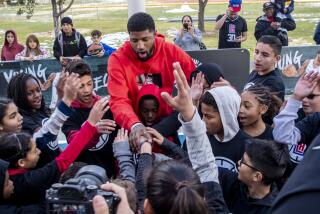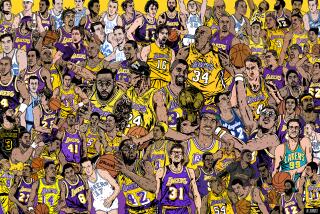Blue Collar : Utah’s Keefe Goes About Job With Down-to-Earth Work Ethic
- Share via
Adam Keefe hasn’t needed a cut man in a month, a season high. No opponent, or Utah Jazz teammate, has clipped his face in that time.
In 35 games, Keefe has needed 28 stitches for various cuts and gashes, from his lower lip to above his left eye. Errant elbows have found their mark far too often this season, in Keefe’s opinion.
Still, there is a subtle message in this carnage.
Keefe, a star at Woodbridge High and Stanford, has adapted in order to survive in the NBA. Once a 6-foot-9-inch, 240-pound, bump-and-grind power forward, he has evolved into a “small” forward by shedding weight and learning how to chase quicker players around the perimeter.
But he still plays with an almost annoying tenacity and baseline-to-baseline persistence, which can cause the occasional laceration.
Those qualities, which helped make him the 10th pick in the 1992 draft that began with Shaquille O’Neal, have kept his career alive. He has finally found his spot, and has the scars to prove it.
“Adam doesn’t jump over anyone, so his face is always at elbow level,” Jazz President Frank Layden said. “But he just keeps sticking his head in there. When Adam arrived here, I told him, ‘Don’t cheat yourself because the next stop is Italy.’ ”
The Jazz, at this point, are not about to say arrivederci.
Keefe has risen from obscurity after struggling in Atlanta. He was traded to the Jazz in September, 1994, for Tyrone Corbin, a deal that dropped Keefe from lottery pick to journeyman status.
But the change of venue has worked.
Keefe returns to Orange County tonight to play the Clippers at the Pond. He is the Jazz’s second-leading rebounder (5.0) and fourth-leading scorer (6.7). Modest numbers, to be sure, but impressive considering the erratic way he is used.
Keefe played 28 minutes, scoring 10 points, against San Antonio Friday. He played six scoreless minutes against Houston Monday. In games where he has played 25 or more minutes, he is averaging 10.2 points and 7.8 rebounds.
Keefe doesn’t try to sort out the thought pattern, he just goes about his chores.
“My primary job is to create havoc,” Keefe said. “On defense, being the guy who rotates to help. On offense, get offensive rebounds and take the pressure off guys. Everyone would like more minutes, but I’m happy with the situation.”
Happy?
Keefe is in the fourth year of a five-year, $7-million contract that will pay him $1.65 million this season and $1.95 million in 1996-97. He has become a fan favorite in a town that idolizes the Jazz. He is playing in a system that suits his nose-to-the-grindstone skills.
Happy? The guy should never stop grinning.
“This is a fun and healthy place to be,” Keefe said. “There’s a real appreciation here for blue collar-type of players.”
An image that fits Keefe snugly.
A group of Jazz players recently participated in a “Stay In School” program at a junior high school in West Jordan, a suburb of Salt Lake City. The players were to talk to students during classroom visits.
Keefe ended up teaching a geography class, using NBA cities to demonstrate the differences in climates. He asked students to decide what clothes they would need to pack if they were drafted by different teams around the country.
“He goes to hospitals and events,” Layden said. “He’s great from a PR standpoint. It makes him more valuable as a player.”
His worth on the court, though, was suspect at first.
Atlanta officials envisioned Keefe as their power forward for years to come. He had the physique and the resume. He averaged 20 points and 10 rebounds as a junior and senior at Stanford and was twice named second-team All-American.
But reactions varied on draft day. When the Hawks announced Keefe, Golden State Coach Don Nelson offered guard Sarunas Marciulionis for Keefe’s rights. On the other hand, Hawk fans, those who had gathered for the draft at the CNN Center in Atlanta, booed.
There were comparisons to Jon Koncak, who flopped with the Hawks after signing a six-year, $13.2-million contract in 1989. Hawk fans have not forgotten that Koncak never averaged more than four points afterward.
That image hurt Keefe more than his play.
“I think there is a stigma about being a lottery pick,” said Pete Babcock, Atlanta general manager. “Everyone is hung up on the sex appeal of the lottery. The misconception is everyone is a great player.”
Keefe averaged 6.6 points and 5.3 rebounds as a rookie. But injuries slowed him his second season. By then, Lenny Wilkins was the Hawks’ coach and day-to-day life became difficult, Keefe said.
“It got to the point where I’d make a pass [in practice] and, if the guy missed the shot, Lenny would stop things and ask me why I would give a guy the ball in that spot,” Keefe said.
“But I have nothing but thanks for the Atlanta Hawks. They brought me into the league and signed me for some nice money. Then they sent me to a team that was making an effort to win a championship.”
Just where Keefe fit into the puzzle was unclear. The Jazz already had perennial all-star Karl Malone at power forward. Malone has missed four games in 10-plus seasons.
Said Layden: “We thought the potential was still there. I didn’t know what the problems were but I said, ‘Let’s get this guy and see if he can live up to that potential.’ ”
That was difficult to assess after Keefe pulled a hamstring before training camp and showed up out of shape.
“We never got a chance to see what kind of game he had,” Coach Jerry Sloan said. “The season started and we were trying to win games, so there was no chance to experiment.”
In December, David Benoit injured his ankle. Keefe had an opportunity. The catch was, he would have to play small forward.
“Yeah, I looked at them kind of funny,” Keefe said.
It was a move that might have salvaged Keefe’s career. True, he had to play facing the basket on offense and chase rabbits on defense, but Keefe averaged 6.1 points and 4.4 rebounds during his on-the-job training.
Keefe voluntarily attended the Jazz’s rookie and free-agent camp in September and reported 20 pounds lighter after an off-season diet and training program. His body fat had dropped from 14% to 7%.
He had 16 points and nine rebounds against Seattle in the season opener.
“Adam is playing so . . . so . . . so quick,” guard John Stockton said afterward. “I think he’s going to be terrific for us. He’s always been a tenacious competitor. He doesn’t mind doing the so-called dirty work.”
Even if it hurts.
Keefe got his first stitches a week into the season and there have been three other wounds since, including one caused by an ally. An elbow by reserve center Greg Foster opened a gash over Keefe’s left eye that required seven stitches. Keefe left that game, but he already had 15 points and seven rebounds in 19 minutes.
“I just didn’t want him to get 30 points,” Foster joked afterward. “I had to stop him some way, so I hit him.”
Keefe may prefer other examples, but every stitch is a sign his career has been patched up.
“The nature of his games means he’s going to get hit,” Sloan said. “He’s always working hard under the basket and goes after those rebounds. You got to love the way the guy plays.”
(BEGIN TEXT OF INFOBOX / INFOGRAPHIC)
Adam Keefe File
* Born: Feb. 22, 1970, in Irvine
* Height: 6-9. Weight: 220
* High school: A two-team All-Orange County selection at Woodbridge, where he led the Warriors to the state Division II championship in 1987. Southern Section 2-A player of the year in 1987 and ’88.
* College: A second-team All-American as a junior and senior at Stanford. Led the Cardinal to the NIT championship in 1991 and was named the tournament’s most valuable player. Averaged more than 20 points as sophomore, junior and senior and led the Pac-10 in rebounding all three seasons.
* NBA: Drafted in the first round--10th player overall--by the Atlanta Hawks in 1993. Traded to the Utah Jazz in 1994 for Tyrone Corbin. Scored a career-high 30 points against Orlando on April 23, 1993. Had a career-high 17 rebounds against New Jersey on Nov. 20, 1995.
More to Read
Go beyond the scoreboard
Get the latest on L.A.'s teams in the daily Sports Report newsletter.
You may occasionally receive promotional content from the Los Angeles Times.







